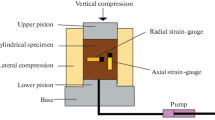Conclusions
The experience gained showed that, increasing the quality and reliability of other types of field investigations, the ADJ method can be used for solving the following problems of engineering-geological surveys: detailed zoning of rock foundations according to jointing, including a determination of the intense weathering zone and determination of the zone of influence of tectonic deformations; determination of anisotropy of the rock mass with respect to jointing; separation of rock members differing in lithological and petrographic characteristics; evaluation of the change in open jointing during thawing of frozen rocks; selection of characteristics areas for conducting costly point field experimental investigations; extension of the results of experimental investigations at individual points to the mass; evaluation of the intensity and depth of alteration of small jointing under the effect of various factors (blasting, stress relief processes, congelifraction, etc.); determination of the thickness of the unloading zone in tunnels and adits.
It is recommended to use the ADJ method at construction sites for checking the quality of the placed concrete, detecting cracks in the concrete structures, evaluating the quality of cementing rocks, selecting the method of conducting blasting operations in order to preserve the foundation rocks, and monitoring the preservation of the rock foundation, particularly when accepting the foundation for concreting works.
Similar content being viewed by others
Literature cited
A. A. Sorokin, “Method of air determination of jointing (ADJ method),” Tr. Gidroproekta, Energiya, Leningrad, No. 27 (14) (1972).
A. A. Sorokin, V. N. Badukhin, and F. V. Shpakovskii, “Method of air determination of jointing or rocks,” in: Summaries of Reports and Communications of the Fourth Conference of Surveyors of Gidroproekt. Engineering Geology Section [in Russian], Informenergo, No. 2 (1972).
V. N. Badukhin, “Importance of combined experimental investigations of exploratory workings in an engineering-geologic evaluation of the rock foundations of hydraulic structures,” Tr. Gidroproekta, No. 46 (1975).
L. S. Miroshnikova and Yu. S. Shevlyagin, “Experience of using air testing of jointing when investigating rock foundations,” in: Summaries of Reports and Communications of the Fifth Conference of Surveyors of Gidroproekt. Engineering Geology Section [in Russian], No. 2 (1975).
F. V. Shpakovskii, “Use of the method of air determination of jointing of rocks at the Zeya hydroelectric station,” Tr. Gidroproekta, No. 46 (1975).
V. B. Mikhailov, “Comprehensive study of rock jointing when conducting on-site deformation investigations at the dam site of the Inguri hydroelectric station,” Tr. Gidroproekta, Moscow, No. 43 (1974).
A. A. Sorokin, “Experience of using the method of air determination of jointing (ADJ),” Tr. Gidroproekta, No. 66 (1978).
F. V. Shpakovskii, The Zeya Dam on the Zeya River. Geology and Dams [in Russian], Vol. 8, Energiya, Moscow (1980).
Yu. S. Shevlyagin, “Experience of using the method of air determination of jointing (“ADJ”) for evaluating the effectiveness of consolidation grouting of the foundation rocks of the Kurpsai hydroelectric station,” in: Engineering Surveys in Construction [in Russian], No. 7 (41) (1975).
Additional information
Translated from Gidrotekhnicheskoe Stroitel'stvo, No. 5, pp. 48–53, May, 1983.
Rights and permissions
About this article
Cite this article
Sorokin, A.A. Experience in using air testing for studying jointing of rocks. Hydrotechnical Construction 17, 264–274 (1983). https://doi.org/10.1007/BF01429045
Issue Date:
DOI: https://doi.org/10.1007/BF01429045




